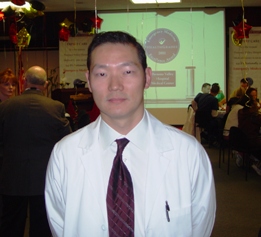
Richard Yochum, PVHMC President and CEO, thanks the hospital's emergency staff for its life-saving work.
This time, thank God, there was no emergency.
This time they could actually sit back and enjoy breakfast as they and their hospital, Pomona Valley Hospital Medical Center (PVHMC), were honored for winning the 2011 HealthGrades Emergency Medicine Excellence Award, a designation recognizing the nation’s top five percent of emergency care-giving hospitals.
“I’m so proud of them,” said Richard Yochum, PVHMC President/CEO said, seconds before officially thanking the hospital’s emergency health care providers. “They work so hard; they’re unsung heroes.”
The hospital center’s selection was based on an analysis of more than 7 million Medicare patient records from 2007 to 2009 by HealthGrades, the nation’s leading, independent source of physician information and hospital quality ratings. HealthGrades focused on 12 of the most common and life-threatening medical emergencies among that patient population, including heart attack, pneumonia, chronic obstructive pulmonary disease(COPD), stroke, heart failure, sepsis, respiratory failure, pulmonary embolism, gastrointestinal bleeds, diabetic acidosis and coma, pancreatitis and bowel obstructions.
According to HealthGrades, Medicare patients treated at a hospital recognized with an Emergency Medicine Award experienced, on average, a 40% lower risk of death compared with patients treated at non-recipient hospitals.
“Pomona Valley Hospital Medical Center, along with its Emergency Department physicians, nurses and other care-givers, has worked to provide healthcare excellence for our patients for decades,” Yochum said. “With 50 beds and various levels of care – from treatment for the most critically ill patients to our Rapid Medical Evaluation (RME) area for less severe presentations – we provide a comprehensive program to treat emergency patients for either admission into to one of the Hospital’s inpatient units or for treatment and discharge.
“We have continually invested in our Emergency Services to best meet the needs of our patients,” he told the hospital’s emergency service providers. “Although we have earned many HealthGrades awards and distinctions over the years, this esteemed honor has been earned not just by our Associates in the Emergency Department but also by those care-givers from throughout the Hospital that work hand-in-hand with our emergency team to provide the continuum of care that is best for our patients.”
PVHMC’s level of emergency care has been even more remarkable given the hospital is on pace to treat about 90,000 emergency room visitors this year, about a 20 percent increase over 2010.

Dr. James Kim is medical director of PVHMC's Emergency Services Department.
“Pomona Valley Hospital’s Emergency Department has several unique programs that distinguish its level of patient care,” added Dr. James Kim, medical director of PVHMC’s Emergency Services Department. “Recently PVHMC’s Emergency Department has implemented three critical care services for the benefit of the community: the STEMI (ST-elevated Myocardial Infarction) Receiving Center (SRC) for patients with this specific type of heart attack that needs immediate, specialized care; Therapeutic Temperature Management for witnessed Cardiac Arrest patients who then undergo the internal lowering of their core body temperature to relieve pressure on the brain and to body to allow them to heal over a period of days; and the newest designation as a certified Primary Stroke Center for patients who must be treated in 4.5 hours post onset of stroke symptoms in order to minimize the complications of stroke.”
The Paramedic Base Station within the Hospital’s Emergency Department is one of 20 such services in Los Angeles County. The Pomona Base Station coordinates the emergency care-givers in the community – Paramedics, Emergency Medical Technicians and fire personnel – and helps direct responding units to available emergency departments in the area with open beds and a qualified level of service.
PVHMC’s ER is designated as a Disaster Resource Center (DRC) coordinating eight to 10 area hospitals in the event of a regional disaster and also as a specified Emergency Department Approved for Pediatrics (EDAP) to ensure the most positive outcomes for children needing emergency care.
The Hospital also provides a unique Safe Surrender unit whereby parents of a newborn, less that 72-hours-of-age, can relinquish their baby anonymously, safely and privately, without fear of criminal prosecution, into a specialized receptacle mounted outside the Emergency Department. The unit was unveiled almost 10 years ago and has helped save the lives of multiple newborns.
Other key findings of the HealthGrades study include:
- The most common causes for admission through the emergency department by Medicare patients were heart failure, pneumonia and chronic obstructive pulmonary disease. The three conditions alone comprised about 3.5 million emergency department admissions, almost half of all the emergency admissions studied.
- The most common causes for admission through the emergency department by Medicare patients were heart failure, pneumonia and chronic obstructive pulmonary disease. The three conditions alone comprised about 3.5 million emergency department admissions, almost half of all the emergency admissions studied.
On average, for the 12 conditions studied, the percentage of cases admitted through the emergency department increased 2.64% from 2007 to 2009.
The findings are based on an analysis of more the 7 million Medicare patient emergency department records from 2007 to 2009.
After breakfast, held at 7:30 a.m. to accommodate the large employee shift change, it was back to work and saving lives for the hospital’s emergency staff. Another day at the office, as it were.
“We’re very excited about the award,” said Darlene Scafiddi, vice president of Nursing. “We know we always give great care, but it’s extra-nice when someone recognizes you.”



Leave a Reply